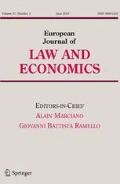Abstract
In a two-sector model, we show that corruption is endogenously determined by the model parameters. It depends on the fraction of unskilled labor and the relative TFP differential between skilled and unskilled sector. First, for a larger proportion of unskilled labor force, there is widespread corruption and for smaller share of unskilled labor force, there is no corruption. For the intermediate level, equilibrium depends on the number of corrupt bureaucrats and there are multiple equilibria. Second, corruption decreases with the relative TFP differential between skilled and unskilled sector. For the intermediate level of TFP differential, there are multiple equilibria. On its consequences, corruption causes rise in the wage inequality between skilled and unskilled workers. It distorts the allocation of resources, which results in the output and the welfare losses, and it is associated with the higher tax rate.
Similar content being viewed by others
Notes
All the data is taken from World Bank’s Enterprise Surveys http://www.enterprisesurveys.org/.
The optimal policy could include some penalty for corrupt bureaucrats, but that is not the focus here.
The government may offer an efficiency wage to get rid of corruption but that may or may not be cost effective for it (as Besley and McLaren 1993 show). And since, here corruption is without theft, therefore we restrain ourselves not to induldge into government’s optimal wage policy problem.
We assume that the amount of bribes recovered from the corrupt bureaucrats is dissipated and it does not appear in the budget constraint of the government.
See Tanzi and Davoodi (2000) for details.
References
Acemoglu, D., & Verdier, T. (1998). Property rights, corruption and the allocation of talent: A general equilibrium approach. Economic Journal , 108, 1381–1403.
Ades, A., & Di Tella. R. (1999). Rents, competition and corruption. American Economic Review, 89, 982–993.
Andvig, J. C., & Moene, K. O. (1990). How corruption may corrupt. Journal of Economic Behavior and Organizations, 13, 63–76
Bardhan, P. (1997). Corruption and development: A review of issues. Journal of Economic Literature, 35, 1320–1346.
Bardhan, P. (2006). The economist’s approach to the problem of corruption. World Development, 34(2), 341–348.
Barreto, R. A. (2000). Endogenous corruption in a neo-classical growth model. European Economic Review, 44, 35–60.
Barro, R. J. (1990). Government spending in a simple model of endogenous growth. Journal of Political Economy, 98, 103–125.
Besley, T., & McLaren, J. (1993). Taxes and bribery: The role of wage incentives. Economic Journal, 103, 119–141.
Blackburn, K., Bose, N., & Haque, M. E. (2006). The incidence and persistence of corruption in economic development. Journal of Economic Dynamics & Control, 30, 2447–2467.
Ehrlich, I., & Lui, F. T. (1999). Bureaucratic corruption and endogenous economic growth. Journal of Political Economy, 107, 270–293.
Foellmi, R., & Oechslin, M. (2007). Who gains from non-collusive corruption? Journal of Development Economics, 82, 95–119.
Fransico, M., & Pontara, N. (2007). Does corruption impact on firms ’ ability to conduct business in Mauritania? Evidence from investment climate survey data. Policy research working paper, No. 4439, The Worldbank.
Gupta, S., Davoodi, H., & Alonse-Terme, R. (2002). Does corruption affect income inequality and poverty? Economics of Governance, 3, 23–45.
Jain, A. K. (2001). Corruption: A review. Journal of Economic Surveys, 15, 71–121.
Mandal, B., & Marjit, S. (2010). Corruption and wage inequality? International Review of Economics and Finance, 19, 166–172.
Mauro Paolo. (1995). Corruption and growth. Quarterly Journal of Economics, 110, 681–712.
Murphy, K., Shleifer, A., & Vishny, R. (1991). The allocation of talent: Implications for growth. Quarterly Journal of Economics, 106, 503–30.
Reinika, R., & Sevenson, J. (2002). Coping with poor public capital. Journal of Development economics, 69, 51–69.
Shleifer, A., & Vishny, R. (1993). Corruption. Quarterly Journal of Economics, 122(1993), 599–618.
Svensson, J. (2003). Who must pay bribes and how much? Evidence from a cross section of firms. The Quarterly Journal of Economics. February 2003.
Svensson, J. (2005). Eight questions about corruption. Journal of Economic Perspectives, 19(3), 19–42.
Tanzi, V., & Davoodi, H. (2000). Corruption, growth and public finance. The Political Economy of Corruption, Hand Book.
Tirole, J. (1996). A theory of collective reputation (with applications to the persistence of corruption and firm quality). Review of Economic Studies, 63, 1–22.
Treisman, D. (2000). The causes of corruption: A cross-national study. Journal of Public Economics, 76, 399–457.
Acknowledgments
I am grateful to Tanguy van Ypersele, Cecilia García-Peñalosa, Patrick Pintus and to seminar participants at GREQAM for their useful comments and suggestions. I would especially like to thank anonymous referee for his helpful suggestions.
Author information
Authors and Affiliations
Corresponding author
Rights and permissions
About this article
Cite this article
Wadho, W.A. Control rights, bureaucratic corruption and the allocation of resources. Eur J Law Econ 35, 41–59 (2013). https://doi.org/10.1007/s10657-010-9185-8
Published:
Issue Date:
DOI: https://doi.org/10.1007/s10657-010-9185-8




